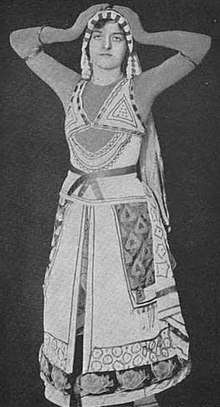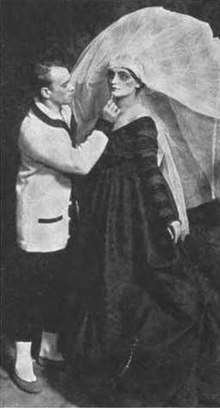Sophie Pflanz
Sophie Pflanz (March 24, 1892 – September 30, 1978), also known as Zofia Maria Pflanz-Dróbecka, was a Polish ballet dancer with the Ballets Russes from 1911 to 1917.
Sophie Pflanz | |
|---|---|
 Sophie Pflanz, from a 1916 publication, wearing a hand-painted costume by Léon Bakst | |
| Born | 1892 |
| Died | 1978 |
| Nationality | Polish |
| Other names | Zofia Maria Pflanz-Dróbecka, Sofie Pflanc, Zofia Maria Pflanc |
| Occupation | dancer |
Early life
Zofia Maria Pflanz was born in Warsaw, the daughter of Wincenty Wilhelm Pflanz and Janina Kazimiera Maria Kęszycka Pflanz.[1] She trained as a dancer in Warsaw, and at the Imperial School in Petrograd.[2]
Career

Pflanz danced with the Ballets Russes under Sergei Diaghilev[3], touring in the company with Adolph Bolm, Léonide Massine, Xenia Makletzova, Valentina Kachouba, Tamara Karsavina, Enrico Cecchetti, and many others. She appeared in productions of Khovanshchina (1913), Papillons (1914), Midas (1914), Prince Igor (1914), and La Légende de Joseph (1914) in Monte Carlo, Paris, and London.[4] On tour with the Ballets Russes in the United States,[5] she danced in Prince Igor, Daphnis et Chloé, Nijinsky's Afternoon of a Faun (1916),[6] Till Eulenspiegel (1916),[7] and Cléopâtre (1917).[8]
After her time with the Ballets Russes, Pflanz returned to Warsaw, where she continued to dance as a soloist, and was head of a ballet company that toured abroad. She taught ballet in Warsaw and later in Torún, for many years.[1] One of her students in Warsaw was Maria Krzyszkowska.[9]
Personal life
Sophie Pflanz married Stanisław Burma-Dróbecki, Diaghilev's private secretary,[10] in London in 1911. She died in 1978, aged 86 years.[1]
References
- polskiego, Encyklopedia teatru. "Zofia Pflanz-Dróbecka". Encyklopedia teatru polskiego (in Polish). Retrieved 2019-04-14.
- Edwards, Aybern (December 1915). "Serge de Diaghileff's Ballet Russe". Vanity Fair. 5: 48.
- Moses, Montrose J. (January 26, 1916). "The Russian Ballet Triumphant". The Bellman. 20: 124.
- Garafola, Lynn; Baer, Nancy Van Norman; Baer, Nancy (1999). The Ballets Russes and Its World. Yale University Press. pp. 315, 317, 329–331. ISBN 9780300061765.
- "Russian Ballet Arrives". The New York Times. January 12, 1916. p. 13 – via ProQuest.
- "Afternoon of a Faun". American Ballet Theatre. Retrieved 2019-04-13.
- "Wonderful Music This Autumn" The Opera News (November 4, 1916): 8.
- Huneker, James (January 1916). "The Russian Ballet". Everybody's Magazine: 146d, 146e.
- Jan Stanisław Witkiewicz, Życie dla tańca (Wydawnictwie Iskry 1998).
- Buckle, Richard (2012-05-01). Nijinsky: A Life of Genius and Madness. Open Road Media. ISBN 9781453249239.
External links
- Troy Kinney, "Sophie Pflanz in Cleopatre" (1917), in the Cleveland Museum of Art.
- A 1917 photograph of Sophie Pflanz, from the J. Willis Sayre Collection of THeatrical Photographs, University of Washington Libraries.